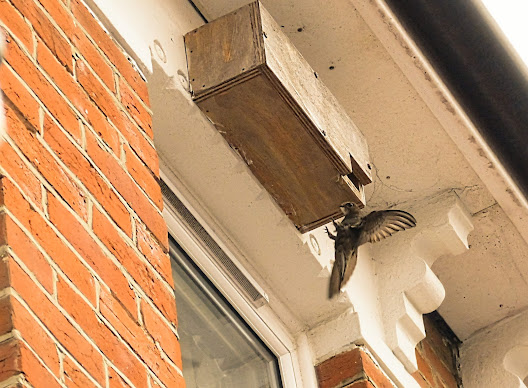Wednesday 10th July 2024.
There were a few bright spells during my walk around the Cemetery.
A much drier day than yesterday though mostly overcast with the occasional sunny intervals. A blustery south-westerly wind was blowing over Southsea this morning as the temperatures climbed up to 17 degrees. Fairly quiet at Pembroke Road, Old Portsmouth, this morning with just 13 species noted during my hour there, with probably the Grey Heron heading west towards the harbour being the only highlight.
This young Herring Gull looks as though it had survived the recent downpours of late. It was seen on the rooftops near my house.
After my first shift, I finally got over my local patch, Highland Road Cemetery, where I have not been for a few weeks and so grabbing the dogs, I made my way to the site, but not before taking a few photos of one of the Herring Gull chicks on a rooftop. This particular bird is now showing the immature bird scapulars. I do hope it gets to adulthood for even when near fledged, they sometimes fall off the rooftops and land in the road only to be squashed by a passing car.
Above, a large spray of both Yarrow and Marrow flowers greet you at the main entrance to the Cemetery. Below, there were actually four Magpies present while I was taking this photo. Sadly, there wasn't many birds to photograph in the Cemy today.
Highland Road Cemetery, Southsea:
As mentioned earlier, a lot can happen within a few weeks and a lot of Cemetery was near unrecognisable with the amount of tree and plant growth around the footpaths. All the Buddleia plants are in flower, of which I scrutinised thoroughly for butterflies and insects and came up trumps with my first Hornet-mimic Hoverfly of the year. There were a good number of Buff-tailed Bumblebees taking advantage of not only the Buddleia, but also a lot of the wild flowers growing on the graves. I saw my first ever Marbled White seen on this site when I first arrived. It was fluttering around the west side of the Cemy, but it would not settle and ended up somewhere in the adjacent gardens. Both Meadow Brown and Red Admiral butterflies were seen, but only the latter hung around long enough for a photo.

Above, Self-heal plants are springing up all over the place now and below, one of most popular plants, the Field Poppy, is also growing abundantly around the Cemetery and attracting the likes of Buff-tailed Bumblebee.
As already mentioned, there were not many birds to take photos and so these Wood Pigeons will have to do. Below, a Meadow Brown butterfly finally settled down after I nearly trod on it.
Around this time of year, there are more insects and wild flowers to check out rather than the birds, as the number of species of birds was low this morning here with just 13 species noted. A Dunnock was heard singing deep within the centre of the Cemy, but as expected, it never showed itself. A few juvenile Blackbirds were seen over in the northern end and a couple of Swifts sailed low overhead. The following birds were noted here:
- Herring Gull
- Wood Pigeon
- Feral Pigeon
- Collared Dove
- Carrion Crow
- Magpie
- House Sparrow
- Wren
- Dunnock
- Blue Tit
- Goldfinch
- Blackbird
- Swift
Above, the result of the Horse Chestnut Leaf Miner moth and below, a few Swifts flew overhead.
Above, one of a couple of juvenile Blackbirds present. I am glad this one has survived so far as I witnessed one being chomped by a Crow the last time I was here. Below, my first Hornet-mimic Hoverfly of the year on Buddliea.
Among the plants noted included the following.
- Wild Carrot
- Common Ragwort
- Purple Toadflax
- Self-heal
- Perennial Sow-thistle
- Cats Ear
- Lesser Bindweed
- Birds-foot Trefoil
- Mallow
- Yarrow
- Ox-eye Daisy
- Scarlet Pimpernel
- Field Poppy
- Lady Bedstraw
There were a few sprays of Wild Carrot present in the northern end of the Cemy which attracted the insects and below, a couple of huge Common Ragwort plants were also attracting the Bees.

This afternoon, my second shift of the day produced a single Mediterranean Gull going over eastbound; a species that is now a daily occurrence. I remember seeing my first Med Gull on Farlington Marshes way back in the early 80’s where I discovered that it had been seen on the Lake. I remember running down to the Lake from the old ‘Warden's Hut’ and was so dismayed in seeing all the Gulls take off. I thought the Gull had gone, but it turned out to be the only bird on the Lake itself! Now, we see them everyday seeing they breed in large numbers now in Langstone Harbour. I see them regularly on the Southsea seafront and always get a buzz when I see these beautiful birds. The Long-billed Dowitcher was still on Normandy Marshes and a Green Sandpiper was nearby. The breeding Roseate Terns are now feeding chicks and entertaining the crowds down for the Dowitcher.







































